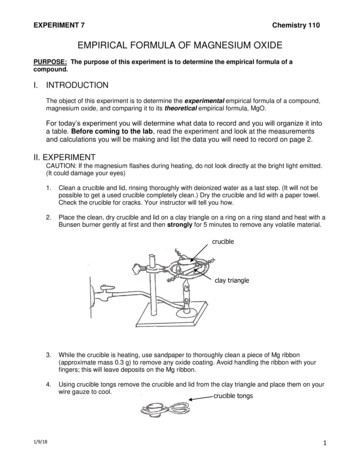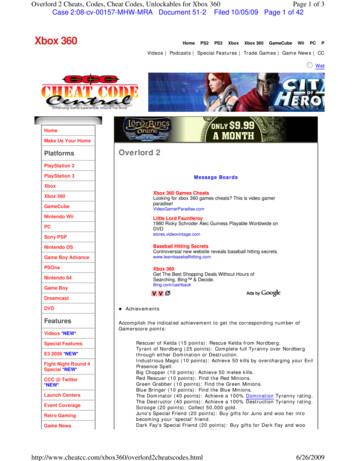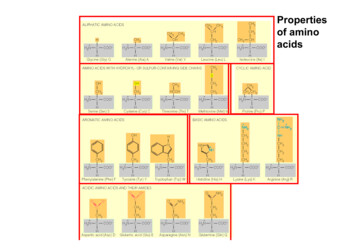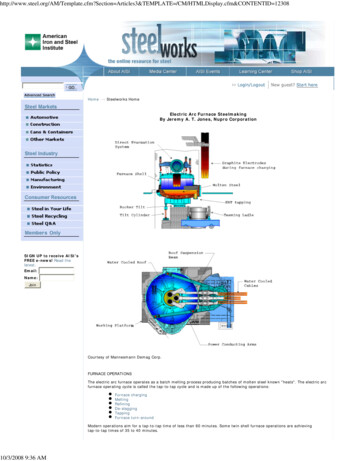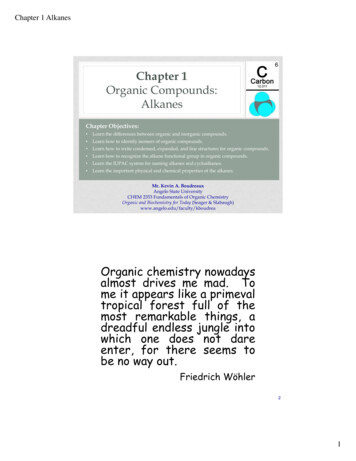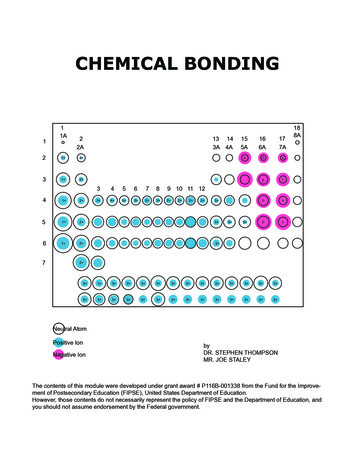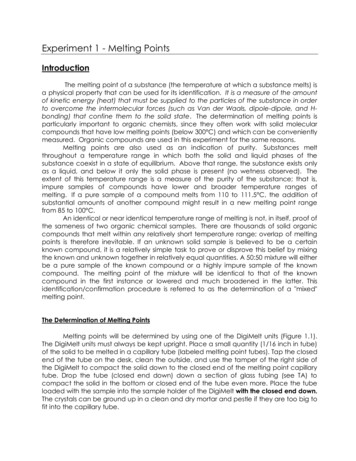
Transcription
Experiment 1 - Melting PointsIntroductionThe melting point of a substance (the temperature at which a substance melts) isa physical property that can be used for its identification. It is a measure of the amountof kinetic energy (heat) that must be supplied to the particles of the substance in orderto overcome the intermolecular forces (such as Van der Waals, dipole-dipole, and Hbonding) that confine them to the solid state. The determination of melting points isparticularly important to organic chemists, since they often work with solid molecularcompounds that have low melting points (below 300 C) and which can be convenientlymeasured. Organic compounds are used in this experiment for the same reasons.Melting points are also used as an indication of purity. Substances meltthroughout a temperature range in which both the solid and liquid phases of thesubstance coexist in a state of equilibrium. Above that range, the substance exists onlyas a liquid, and below it only the solid phase is present (no wetness observed). Theextent of this temperature range is a measure of the purity of the substance; that is,impure samples of compounds have lower and broader temperature ranges ofmelting. If a pure sample of a compound melts from 110 to 111.5 C, the addition ofsubstantial amounts of another compound might result in a new melting point rangefrom 85 to 100 C.An identical or near identical temperature range of melting is not, in itself, proof ofthe sameness of two organic chemical samples. There are thousands of solid organiccompounds that melt within any relatively short temperature range; overlap of meltingpoints is therefore inevitable. If an unknown solid sample is believed to be a certainknown compound, it is a relatively simple task to prove or disprove this belief by mixingthe known and unknown together in relatively equal quantities. A 50:50 mixture will eitherbe a pure sample of the known compound or a highly impure sample of the knowncompound. The melting point of the mixture will be identical to that of the knowncompound in the first instance or lowered and much broadened in the latter. Thisidentification/confirmation procedure is referred to as the determination of a "mixed"melting point.The Determination of Melting PointsMelting points will be determined by using one of the DigiMelt units (Figure 1.1).The DigiMelt units must always be kept upright. Place a small quantity (1/16 inch in tube)of the solid to be melted in a capillary tube (labeled melting point tubes). Tap the closedend of the tube on the desk, clean the outside, and use the tamper of the right side ofthe DigiMelt to compact the solid down to the closed end of the melting point capillarytube. Drop the tube (closed end down) down a section of glass tubing (see TA) tocompact the solid in the bottom or closed end of the tube even more. Place the tubeloaded with the sample into the sample holder of the DigiMelt with the closed end down.The crystals can be ground up in a clean and dry mortar and pestle if they are too big tofit into the capillary tube.
If the melting point of the sample is unknown or unavailable, a fast run with theDigiMelt set at a ramp of 10 or 20 C per minute to obtain an approximate meltingrange. A more precise value can then be obtained by heating the DigiMelt moreslowly at a slower ramp (about 2 C/min.) starting 5-10 degrees below the temperatureat which your sample first began to melt.Figure 1.1: The DigiMelt apparatus. Melting point capillary tubes are placed(closed end down) in the slots directly in front of the magnifying lens where they areviewed during melting. Up to three samples can be viewed at once. The heating rateof the DigiMelt is adjusted by setting a temperature ramp along with a start and endtemperature following the "Quick Start Instructions" on the front of the DigiMelt. A rampof 20 C per minute will result in a rapid temperature rise while a ramp of say 2 C perminute will give a slower rise that will more accurately measure the melting range of asolid.
Record the temperature that the crystals begin to melt (crystals will look wet) and thetemperature at which the substance becomes a clear liquid with no solid materialremaining. This is the melting range. The DigiMelt provided a digital readout of thetemperature. Equipment is not calibrated and may be off as much as 3oC. Consequently, do not expect the melting points obtained with the DigiMeltapparatus to be identical to those listed in the Table shown on page 3. The calibrationof the DigiMelt thermometer will be checked using the melting range obtained for pureurea or pure cinnamic acid. Use the same DigiMelt for all your measurements.The ExperimentPrelab Work: Answer the prelab questions at the end of this write-up on a piece of looseleaf paper (not in lab notebook) after you have read the experiment. A quiz will begiven at the start of the period covering the introduction and this experiment in thelaboratory manual, any lab lecture material from last week or this week, and the prelabquestions.Laboratory Notebook: Be sure to read the section on the laboratory notebook in theintroduction of the laboratory manual. All data, calculations, observations, andconclusions should be recorded directly in the laboratory notebook. Be sure to save thefirst two pages of the notebook for a table of contents. Results for unknowns arereported by filling a report sheet found at the end of the experiment and giving thesheet to your TA or stockroom (216).Supplies: DigiMelt, Capillary Tubes (closed end), mortar & pestle, cinnamic acid, urea,and chemicals in the table below. If possible, use the same DigiMelt for all your work.CAUTION: All the used chemicals for this experiment should be placed into the bottlemarked “Waste Organic Solids.” Used capillary tubes should be thrown in the brokenglass container. Avoid contact with these chemicals; some are irritants or aretoxic. Wash your hands when finished.
Table 1.1: Melting Ranges of a Various Organic aic AcidHazardCode1102211131110011o-Toluic Acid*m-Toluic Acid*ResorcinolBenzoic AcidUreaCinnamic Acid101110113111121321221113Acetylsalicylic AcidMaleic AcidBenzilic AcidAdipic AcidCitric AcidMannitol211221122121120211230201Tartaric AcidItaconic AcidSuccinic AcidAscorbic AcidCholic Acid11110112011111112011***Description/UsesNatural vanilla flavoringMinor constituent of coal tarSolvent, plasticizer, stabilizerRancidification product of fatscontaining oleic acidsSubstituted benzoic acidSubstituted benzoic acidDisinfectantFound naturally in berriesUsed as fertilizerOxidation product of cinnamonoilAspirinManufacture of resinsA carboxylic acidUsed to manufacture nylonSour taste of citrus fruitsManufacture of radiocondensersIn soft drinks, cream of tartarA dicarboxylic acidManufacture of dyes, perfumesVitamin CEmulsifies fats in the intestineMelting 200These two compounds are isomers.These melting points may vary according to supplier. Be sure to run a "mixed melting" rangein identifying unknowns.Melting Points and Mixed Melting Points of Compounds Having Similar Melting PointsDetermine the melting points of pure samples of cinnamic acid and urea as wellas a 50:50 mixture of the two, and record the data in your lab notebook. The threesamples can be run simultaneously in the DigiMelt (use temperature range of 110-140oC). To prepare a 50:50 mixture, mix equal small portions of these compounds (estimatethe amount of each, about 0.02-0.06 g). Grind the mixture to a fine powder mix in aclean, dry mortar and pestle provided. Wash the mortar and pestle with soap andwater, rinse with tap water, distilled water and acetone in hood to clean and dry.Is the melting point of the mixture different? If it is different explain why. If themelting point of urea differs from the value listed by more than as 3 oC see your TA.You may have to repeat the melting point of urea and Cinnamic Acid.
The UnknownTo identify your unknown you must first measure its melting range. Tap a smallamount of your unknown into two different capillary tubes. Just a few crystals areadequate. You may need to grind some of your unknown into a powder if it is toocoarse to fit into the capillary tube. Find the melting point range of the pure unknownsubstance by first quickly determining an approximate melting range on a fast ramp (20oC/min from 70-210 oC) and then doing a slow, careful melting range with the secondcapillary tube you prepared (use a ramp of 2 oC/min and start about 15 oC below themelting range to 10 oC above the range). Make sure the DigiMelt is below 70 oC beforestarting the first melting range and 10-20 oC below the compound’s melting rangebefore doing a slow careful melting range. Run cinnamic acid again with the unknownif the calibration was off.Using the melting ranges listed in the table on the previous page determinewhich possible compounds are within 8 oC of your unknown's melting range. Make a50:50 mixture of the unknown with each of these possible compounds and carefullygrind each mixture to a homogenous powder in a clean dry mortar and pestle. Takethe melting range of each mixture at the same time using a slow ramp (2 oC/min) with astarting temperature 20 oC lower that the slow run done with the unknown. Record all ofyour results on your report sheet. The mixture where the melting point does not changeindicates that the two compounds in the mixture are the same. Clean the mortar andpestle and return to the storage location in the lab. You should now be able to identifyyour unknown and complete the report sheet for this experiment. Record, all results andanswers to questions in your laboratory notebook.
Prelab Questions1. Two samples have the exact same melting points. Are they the same compound?How could you tell for sure?2. You have two samples of mannitol. One melted between 168º-169º and the othermelted between 161º-168º. Which sample has the greater purity? Why?3. Which would be the best way to determine the melting point of a compound? Why?a.Slowly run two very precise melting points.b.Run a very precise melting point and then run a fast one to double check yourwork.c.Run a quick melting point for an approximate melting range, then a slowprecise one.4. Risk Assessment: What are the safety hazards and precautions for this experiment?5. How much sample needs to be placed in the capillary tube to determine a meltingpoint?6. How do you place the capillary tube in the DigiMelt?7. Explain how a "mixed" melting point can be used to confirm the identity of acompound.8. Name three intermolecular forces that hold organic molecules together as solids.
CHM 235L - Melting Points Experiment Determination of Melting PointsName Dana IDSection Letter Locker # Work Station # DateA. Determination of the melting points of pure cinnamic acid, pure urea, and a 50:50mix.Melting RangeCompoundB.StartFinishCinnamic AcidºCºCUreaºCºC50:50 MixtureºCºCDetermination of Identity of an UnknownMelting Range of Unknown ºCMixed melting points (50:50 mix of unknown with compounds of similar meltingranges from table 1.1):MixtureMelting RangeUnknown & – ºCUnknown & – ºCUnknown & – ºCUnknown & – ºCIdentification of UnknownFor Unknown #Turn in this completed report sheet to your TA before the end of lab.
EXPERIMENT 2: DISTILLATION AND GAS CHROMATOGRAPHYOBJECTIVESIn this experiment a simple and fractional distillation of mixtures of cyclohexane andtoluene will be conducted. Gas chromatography will be used to analyze samples todetermine the effectiveness of distillation.INTRODUCTIONThe separation of organic compounds is one of the most important tasks of theorganic chemist. Organic compounds seldom occur in pure form in nature or asproducts of a laboratory synthesis. The most commonly used method for purification ofliquids is distillation, a process by which one liquid can be separated from anotherliquid, or a liquid from a nonvolatile solid.Example: When water is heated with a heating mantle in a simple distillation apparatus (see fig.1 inappendix), the vapor pressure of the liquid, or the tendency of molecules to escape from the surface,increases. This process continues until the vapor pressure becomes equal to the atmospheric pressure, atwhich point the liquid begins to boil. Addition of more heat will supply the heat of vaporization required forconversion of the liquid water to gas (steam), which rises in the apparatus, warms the distillation head andthermometer, and flows down the condensing column. The cool walls of the condenser remove heat fromthe vapor and the vapor condenses back to the liquid phase. Distillation should be conducted slowly andsteadily and at a rate such that the thermometer bulb always carries a drop of condensate and is bathedin a flow of vapor. Liquid and vapor are then in equilibrium, and the temperature recorded is the trueboiling point. If excessive heat is applied to the walls of the distillation flask above the liquid level, the vaporcan become superheated, the drop will disappear from the thermometer, the liquid-vapor equilibrium isupset, and the temperature of the vapor rises above the boiling point.Consider the separation of cyclohexane (81 C) and toluene (111 C). Mostcommonly, reported boiling points are at sea level and will always be lower thanreported; the boiling point of water is 100 oC; at 7000 ft elevation it is 93 oC. Using asimple distilling apparatus a mixture of these two miscible liquids starts to distill slightlyabove the boiling point of cyclohexane and stops distilling somewhat below the boilingpoint of toluene. All fractions of the distillate are mixtures and little separation of the twocompounds is achieved. If redistillation is repeated often enough, the two componentsof the mixture will eventually completely separate. Fortunately this series ofcondensations and redistillations is done automatically in a fractionating column.The fractioning column shown in fig 3 of the appendix contains a stainless steel orcopper scouring sponge, which forms a porous packing for the equilibration of vaporand condensate. Increased surface area and the materials surface tension play a rolein how well these compounds are separated. At the start of the distillation of a mixtureof cyclohexane and toluene the mixture boils and the vapors condense in the lowestpart of the fractionating column.
The composition of this condensate is similar to that of the first fraction collectedin a simple distillation; richer in cyclohexane than in toluene, but by no means purecyclohexane. Then, as more cyclohexane and toluene boil, the temperature of thesevapors is higher than that of the first portion of the mixture, because the portioncontains less cyclohexane and more toluene. These hot vapors contact the liquidalready in the fractionating column from the first part of the distillation and a heattransfer takes place, which causes the more volatile component (cyclohexane) to boilfrom that liquid. A succession of these condensations and vaporization occurthroughout the column with a continually purer mixture found at the top of the column.The efficiency of a column is rated by the number of simple distillations that take placeinside the column. After cyclohexane–toluene vapor has warmed the entire length ofthe column, the less volatile part condenses and trickles down over the surface of thepacking, while fresh vapor from the flask forces its way through the descendingcondensate with attendant heat interchange. A number of equilibrations betweenascending vapor and descending condensate take place throughout the column. Thevapor that eventually passes into the receiver flask is highly enriched in the morevolatile cyclohexane, whereas the condensate that continually drops back into theheated flask is depleted of the volatile component and enriched with the less volatiletoluene. The packaging is used in the column to increase the vapor-liquid contactarea. Since equilibration is fairly slow, slow distillation effects better separation.A process similar to fractional distillation is used to process and produce gasolinefrom crude oil. Gas chromatography is a technique that can be use to analyze volatileorganic liquids identify and determine purity of samples. See the appendix for moreinformation on distillations and gas chromatography.EXPERIMENTAL PROCEDUREThis experiment will be done individually. If contrasting simple vs. fractionaldistillation as instructed by your TA, you will need to share data with one other person.Glassware and EquipmentSimple Distillation: 50 mL and 250 mL round bottom flasks, 3-way connecting tube, Westcondenser, vacuum connecting tube, straight tube adaptor, 50mL graduated cylinder,two or three ring stands, 250 mL heating mantel and voltage controller, 3-4 clamps andclamp holders, ring support, thermometer, thermometer holder, boiling chips, ice.Fractional Distillation: Additional equipment including Simple Distillation equipment:condensing column, steel wool.Other Equipment: Gas chromatograph.
Chemicals: 50 mL of toluene/cyclohexane mixture per distillation.Cautions: Goggles must be used at all times. Toluene (2301) and cyclohexane (2302)are flammable and moderately toxic. Keep away from sources of ignition and avoidcontact with skin. Gloves are available for use. To prevent fumes from escaping into thelab, all manipulations of cyclohexane and toluene must be done in a fume hood.Review the safety information in the lab manual introduction with a focus on fumehoods and fire safety. In addition transport of these outside of a fume hood should onlybe done in stoppered containers. Also, any glassware used should be rinsed with asmall quantity of acetone ( 5 mL) in a hood before washing in a sink with soap andwater.1. Thermometer CalibrationTest the 0 oC point of your thermometer with a well-stirred mixture of crushed ice anddistilled water. Check the boiling point with water with the thermometer; this isapproximately 93 oC. Your TA will setup these baths for the class to use.Exposing thethermometer to extreme temperature ranges can cause the glass to shatter. Do notplace the thermometer in the ice bath and then immediately into boiling water or viceversa.2. Simple DistillationApparatus: Assemble the apparatus for simple distillation shown in Fig 1 of theappendix. Place the flask with the liquid to be distilled inside the heating mantel. One ortwo boiling stones are put in the flask to promote even boiling. Each ground joint islightly greased by putting a thin film of grease length wise around the male joint andpressing the joint firmly into the female. Air is eliminated and the joint will appear almosttransparent. (Don’t use excess grease as it will contaminate the product.). Water iscirculated through the outer jacket of the condensing column; it enters the condenserat the lower entrance to the condenser jacket (closest to receiving flask). Because ofthe large specific heat capacity of water only a very small stream (3mm diameter) isneeded; too much water pressure will cause the tubing to pop off. A heavy rubberband or clip can be used to hold the condenser to the distillation head. Note that thebulb of the thermometer is placed below the opening into the side arm of thedistillation head. Collect the distillate in a 25 or 50 mL graduated cylinder.Simple Distillation of Cyclohexane-Toluene Mixture: Place 35 mL of an unknown mixtureof cyclohexane and toluene, 2-4 boiling chips in a dry 250 mL round bottom flask andassemble the apparatus for simple distillation. After making sure all ground glassconnections are tight, heat the flask strongly until boiling starts by setting voltage of thepower supply around 70 V and then backing off to 50 V as needed. Adjust the heating
mantel until the distillate drops at a rate of about 1 drop per second. Record both thetemperature and the volume of distillate at regular intervals to plot graphically later.Take a sample for GC analysis in a clean dry vial when 3 mL have distilled over. Whenthe temperature begins to increase more rapidly switch the receiving flask with anotherdry/empty one. There may not be a clear change in temperature when you begindistilling toluene instead of cyclohexane. Pour the already collected distillate into aclean, dry flask and stopper it. After about 33 mL of distillate have been collected,discontinue the distillation by simply turning the power off to the heating mantle. Neverdistill to dryness. With your TA’s assistance, run a gas chromatogram (GC) on thesample collected. Make any thermometer correction as necessary and plot boilingpoint vs. total volume of distillate collected as shown in figure 5 of the appendix. Graphusing Excel or Graphical Analysis.3. Fractional DistillationApparatus: Assemble the apparatus shown in Fig. 3 in the appendix. The fractionatingcolumn should be placed vertically and loosely packed with stainless steel or copperwool.Fractional Distillation of a Cyclohexane-Toluene Mixture: Obtain 35 mL of an unknowntoluene-cyclohexane mixture and place and transfer into a clean, dry 250 mL roundbottom flask. Attach the flask to the fractional distillation apparatus. Apply heat andquickly bring the mixture to a boil. Collect the distillate in an ice cooled 50 mLgraduated cyliner. As soon as boiling starts, turn the heating mantel to the smallestsetting that boils the liquid. Heat the flask slowly at first. The upper edge of condensatewill rise slowly through the column. The rise should be very gradual, in order that thecolumn can acquire a uniform temperature gradient. Do not apply more heat until youare sure that the ring of condensate has stopped rising, then increase the heatgradually. In a properly conducted distillation, the vapor-condensate mixture reachesthe top of the column only after several minutes.Once distillation has commenced, it should continue steadily without any drop intemperature at a rate not greater than 1 mL in about 2 minutes. Observe the flow andkeep it steady by slight increase in heat as required. Record the temperature as eachmilliliter of distillate collects. Take a sample for GC analysis in a clean and dry, cappedvial when 3 mL have distilled. Pour all the distillate before the temperature rise into oneErlenmeyer flask and stopper it. Stop the distillation when you have collected about 33mL after a second constant temperature is reached. Plot a distillation curve as shownin figure 5 of the appendix. Run a gas chromatogram on the first low boiling fractionand give this product to your TA. Place all of the cyclohexane/toluene distillates into thebottle labeled “Cyclohexane/Toluene Distillates”. All other used chemical and rinses areplaced into the “Acetone Waste” bottle.
Data Analysis Gas Chromatographs taken.Plots of volume versus temperature for both the simple and fractional distillation.Calculations showing the percent composition of toluene and cyclohexane inthe original mixture from the distillation curve and the GC data.Write a paragraph interpreting the distillation plots and GC data. Compare theeffectiveness of the two types of distillations.Pre-Lab Work1. Read experiment and the appendix covering distillation and gas chromatography.2. Draw pictures of a simple & fractional distillation & label all the components of each.3. What is the difference between a simple and fractional distillation?4. Briefly describe how a fractional distillation separates volatile organic liquids.5. What is a gas chromatograph used for in this experiment?6. Draw a schematic of a gas chromatograph and describe how it works7. List three ways to prevent fumes from escaping into the lab room.8. Risk Assessment: What are the safety hazards and precautions for this experiment?
EXPERIMENT 3: SEPARATION OF ORGANIC MIXTURES ANDIDENTIFICATION OF ORGANIC COMPOUNDS.INTRODUCTIONA common problem encountered in chemistry involves the separation of amixture of multiple compounds into isolated fractions followed by the purification andidentification of each. To effect the separation, a chemist must take advantage ofdifferent properties of the mixtures’ components. Differences in solubility, density, acidbase chemistry and reactivity are utilized to separate a mixture of compounds. Eachcomponent of the mixture is then purified and identified. The components will beunknown to the student except that one compound is a liquid neutral organiccompound with a high boiling point and the other a carboxylic acid. The carboxylicacid can react with a base such as sodium hydroxide to form an anion which is watersoluble. The organic neutral molecule does not react in the presence of hydroxide,keeping it a water insoluble compound. The possible organic neutral compounds arelisted in table 3.1.Carboxylic acids are compounds which include one or more carboxyl functionalgroups (below). A functional group can be defined as an atom or group of atoms in adefinite structural arrangement that influences the properties of an organiccompound. The carboxyl group gives the following possible unknowns their acidiccharacter.OROHFigure 3.1: General carboxylic acid structureOnce the unknown neutral and acid compounds have been separated and purifiedthey will then be identified, the neutral compound via its infrared spectrum and thecarboxylic acid via its melting range.
Table 3.1: Possible Neutral Unknown Compounds and Boiling PointsFunctional GroupCompoundB.p. (oC)Baker nolAlcoholsOHBenzyl itrileNitrilesNBenzonitrileExtractionHere, R stands for any group of atoms attached to the functional groupCOOH. As with any Brønsted acid, a carboxylic acid reacts with hydroxide ion, OH-, toproduce the conjugate base of the acid, the carboxylate ion and water as abyproduct. The carboxylic acid is soluble in organic solvents but insoluble in water. Thecarboxylate ion is water soluble and insoluble in organic solvents. This reaction changesthe solubility properties of the acid molecule. We can take advantage of theseproperty changes in separating the acid from the mixture.
OOROH --HORO H2OReaction 3.1: Carboxylic acid reactions with hydroxide forming the carboxylate ion.TABLE 3.2: Possible unknown carboxylic acids.Compoundo-Toluic Acid (2-Methylbenzoic acid)Azelaic Acidm-Anisic Acid (3-Methoxybenzoic acid)2-Phenoxypropionic acidBenzoic AcidSebacic AcidCinnamic Acid1-Naphthoic AcidSalicylic Acidp-Toluic Acid (4-Methylbenzoic acid)p-Anisic Acid (4-Methoxybenzoic acid)Melting Range ( 5157-160158-160180-182182-185Baker The neutral component of the mixture may be any one of the hydrocarbons,alcohols, ketones, or nitriles listed in Table 3.1. Neutral compounds will not react witheither an acid or a base. Additionally, the neutral compounds are also water insolublebut very soluble in organic solvents.The Separation of the Aqueous and Organic LayersThe variations in solubility of both components have been identified which willallow for their separation. A technique called liquid-liquid extraction takes advantageof the differences in solubility of the components by shaking the neutral and carboxylicacid with two immiscible solvents.The organic solvent will be tert-butyl methyl ether (TBME) and the polar aqueouslayer will be a 5% NaOH solution or water. The density of TBME is 0.74 g/mL and thedensity of the NaOH solution is approximately 1 g/mL.Initially the mixture of the neutral organic and carboxylic acid unknowns will bedissolved in TBME forming an organic solution. This organic solution is shaken with adilute aqueous sodium hydroxide solution and then allowed to stand until the two layersseparate. During the shaking process, the hydroxide ion reacts with the carboxylicacid component of the mixture to form the water soluble carboxylate anion (Reaction
1). This changes the solubility of the acid resulting in most of it moving from the organicliquid layer and becoming solvated by the aqueous layer. The aqueous layercontaining the carboxylate anion and the organic layer containing the neutral organiccompound are allowed to separate and these phases are then separated into twofractions by draining the lower, aqueous layer.The two phases will separate and form two separate layers based on differencesin polarity and density. The organic layer is much less polar and has a much lowerdensity compared to the diluted NaOH solution. Sometimes the difference in polarityand/or density of the two phases may not be great enough to effect a separationcausing the formation of an emulsion. The separation can sometimes be improved byadding more NaOH solution or TBME solvent.It is important to note that single extractions often do not yield a completeseparation, and multiple extractions may be needed. In your work, you will extract theoriginal organic solution two times with aqueous sodium hydroxide solution to removethe acid and water soluble impurities from the organic layer. The two aqueous extractsare then combined and set aside as the aqueous sodium hydroxide fraction. Theorganic solution is further extracted once with distilled water to remove any traceamount of water soluble impurities. Once these extractions are complete, the organicsolution should contain only the neutral organic compound and the organic acid has
laboratory manual, any lab lecture material from last week or this week, and the prelab questions. Laboratory Notebook: Be sure to read the section on the laboratory notebook in the introduction of the laboratory manual. All data, calculations, observations, and conclusions should be recorded directly in the laboratory notebook.



